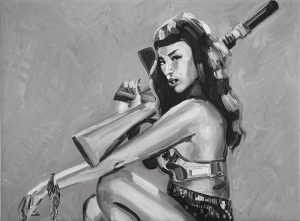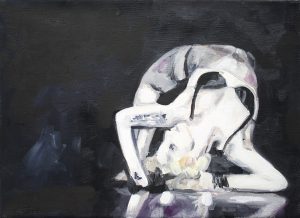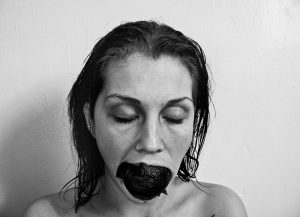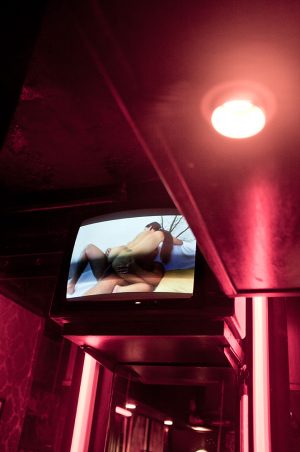When the 2015 Montana Literature Prize was awarded to Christina Hagen (b. 1980) for Boyfrind (2014), her older colleague and member of the judging panel, Kirsten Thorup, commented that the work shared similarities with contemporary concept and performance art. She was referring to the way in which Boyfrind, with its coffee-table format and mix of genres (of images and text, fact and fiction, etc.), challenges the reader to find new approaches to ‘reading’. From the very outset, the cover suggests an unconventional, almost pornographic aesthetics: a cropped picture of a naked fleshy male stomach and thigh, the flaccid penis, across which the title is written in a pink childlike hand, with incorrect English spelling and a red heart dotting ‘i’. Another member of the judging panel, literary scholar Tue Andersen Nexø, called this a ‘gurlesque’ aesthetics, using a term Swedish author and scholar Maria Margareta Österholm (2012) has transposed from subculture to denote a literary style. The word ‘gurlesque’ is a combination of ‘girl’ (which 1990s’ neo-feminists turned into ‘grrrl’) and ‘burlesque’ (of satyr plays: coarse/sexually provocative). Österholm uses the term to denote a distinct tendency in recent Swedish literature dealing with “skeva”, or queer/strange/twisted, girls and young women who, while asserting their gender, subvert the boundaries of ‘appropriate’ behaviour for their gender, not least sexually. (Maria Margareta Österholm: Ett flicklaboratorium i valda bitar: Skeva flickor i svenskspråkig prosa från 1980 till 2005. Rosenlarv Förlag, 2012)

In this article, the performative experimentation and the gurlesque stylistic features in Christina Hagen’s work will be considered as illustrative of a generation of Nordic female writers born between 1970 and 1980 and publishing their first works around 2000. In various ways, they have (re)placed themes such as gender, body, and sexuality on the literary agenda. Not vociferously and under political banners like in the 1970s, but by utilising performative features. In Christina Hagen’s work, these are also manifested in, for example, a happening-like staging, using stand-ins/doubles at public appearances in order to emphasise the way in which gender and looks play a role in reference to and evaluation of, in particular, young female writers. As Österholm has put it in her semi-fictional book, Den unga F:s bekännelser (2014; The Confessions of Young F), the F-word has become literary chic for young women writers, but in new and more subtle forms. F might stand for ‘flicka’, or girl in Swedish, (female), as well as ‘femme’ (i.e. a feminine, so-called ‘lipstick lesbian’), or ‘feminist’. The form and style are simultaneously humorous and coarse, material-sensual, and imaginative – and the authors are in ongoing dialogue with topical ideas of gender philosophy.
This article is about a millennium generation of female writers who fall within the above introductory characterisation. Beside Christina Hagen, they include Danish writer Kristina Nya Glaffey (. 1979), Swedes Maria Margareta Österholm and Mara Lee (b. 1972), and Norwegian Trude Marstein (b. 1973). Other writers would be relevant in this context, but they are discussed in other articles (for example, Sara Stridsberg from Sweden, and Sofi Oksanen from Finland), or they are seen as being closer to other genres (Danes Lone Hørslev and Maja Lee Langvad as poets) or art forms (Danish Eva Tind as painter). It is characteristic of the writers highlighted here that they explore the depths in modern sexual life and the relationship to the body and the paradoxes therein. While the boundaries of normality are expanded – with, for example, general acceptance of homo- and bi-sexuality – the boundaries of normality are narrowing, in step with the demands and expectations of the right body and the proper (family) life. It is particularly through the exposure of these ‘normalisation strategies’ and the patterns of escape, evasion, and rejection they cause, that this generation of writers has made itself felt, given that they more or less explicitly enter into dialogue with gender theorists such as Judith Butler, Judith Halberstam, and Sara Ahmed. Furthermore, they make their mark by calling attention to the intricate interplay – not just between gender and sexuality – but also between race/ethnicity, age, and ability, and they have a broader, global view and understanding of urgent worldwide issues such as the climate, the environment, and health.
New Forms of Living Together and New Family Constellations
The writer dealing most directly with these new forms and themes is Kristina Nya Glaffey, especially in her novel Padder og krybdyr (2012; Amphibians and Reptiles). It is constructed around a series of questions faced by a lesbian couple considering having a child through donor insemination: “Did they want to have children, and if they did, should they both get pregnant, and should they be pregnant at the same time, and if not, which one should get pregnant, and how should they conceive the child, and, should the occasion arise, who should be the father, and should there be a father at all, and did a child have the right to a father, and did a woman have the right to a child?” The novel may be read as a very direct contribution to debates on new developments in fertility technology and particularly about the rights of lesbians, gays, and other ‘queer’ lives in global manoeuvres around reproductive resources. However, it does not offer clear-cut or easy answers. Rather, the novel uncovers the complexity of the questions raised, the ending as open as the beginning: in the ethical dilemmas confronting the lesbian narrator by virtue of being a participant in this manoeuvring. These dilemmas are developed by way of an italicised inner monologue, which sets a performative framework of appeal around a longer, more fact-based central part.
The narrator is initially motivated by her surprise that public debates, despite the scope and proliferation of new technologies, are dominated by the highly traditional position that the modern human is controlled by an animal reproductive instinct, which must be ennobled in and by “the sacred (marital) alliance” and “the trinity of mother-father-child”. This argument provides the option of playing the nature vs. nurture cards, depending on which position supports the argument at hand. For this very reason, it is also an argument that the emerging fertility industries may employ in their marketing efforts, e.g. when selling sperm and, on the one hand, stressing biology and inherent genetic qualities while, on the other hand, arguing that technologies of assisted fertility may assist in the establishment of the universal nuclear family – without, regardless of biological obstacles or ties, so to speak. Glaffey’s sharp, satirical pen lashes out at the companies involved, including recognisable Danish sperm banks catering for a homosexual consumer segment with money to spend. She also writes ironically, however, of the LGBT-lobbies turning the battle for the right to have and bring up children into a battle for the right to have a “happy object”. By so doing, they replicate the nuclear family norm as phrased by the British-Australian scholar, Sara Ahmed, when addressing issues of feminist, queer, and race theory in The Promise of Happiness (2010): “Sharing the family means sharing happy objects”. Glaffey therefore, has her narrator constantly turning over her own motives and actions, her own and her partner’s desire to have and raise their own children (with which at least one of them will be biologically related), and form a nuclear family. What is this desire, what are its constituent parts? To the extent that Glaffey does present her own view, it is that homosexuals should rather argue for new and diverse ways in which to form ethically justifiable communities for children and adults. They ought to enter into a more open and proactive debate about new fertility technologies and its concomitant fiscal, legal, and (sexual)political aspects.

In this novel, as in all her writing, Glaffey draws very directly on recent theories of gender and sexuality, playing with them in an affectionate-ironic style. She draws, in particular, on the work of American feminist philosopher and rhetorician, Judith Butler, whose works are incorporated explicitly in the text. In gender-philosophical classics such as Gender Trouble (1990) and Bodies that Matter (1993), Butler has dissected the “heterosexual matrix”, according to which there are two legitimate and complimentary genders, whose desire are directed towards one another in an active-passive polarity of masculinity and femininity. Other forms of gender and sexuality combinations are positioned, according to Butler, on the fringes of culture and are branded (to varying degrees) as deviant and illegitimate. They nonetheless comprise a constant threat to conformity, which may only be maintained as a fragile social ‘miming’ of the conventional scripts. With her theory, Butler has presaged a queer theory and sexual politics through which the ‘queer’ combinations of gender and sexuality are celebrated and normality is rendered queer in a kind of double inversion. This also occurs in the work of American queer feminist, Judith “Jack” Halberstam, whose Gaga Feminism (2012) addresses the many new expressions of gender and forms of relationship and intimacy, which circulate globally by virtue of, for example, new media, as “the end of normal”. The term ‘Gaga feminism’ was inspired by Lady Gaga, the global music icon known for her ‘gurlesque’ style of performance, challenging notions of gender and sexuality on the borderline between pop and avant-garde.
While Butler and Halberstam consider homosexual partnerships and parenthood as ways of rupturing the norm, Glaffey takes a more (self-)critical view of them as a mime which corroborates norms to the same degree that it challenges the same norms, making the homosexual family ‘the new normal’ so to speak. At the same time, she positions herself where it hurts by pointing out how the reproductive norm has also shaped the narrator, who shares many attributes with the author of the novel, and how it has become, in a manner of speaking, her own personal flesh and desire. In the novel, Mor og Busser (2014; Mum and Busser), Glaffey plays out, in pure gaga-humorous fashion, this entire complex as it appears from a child’s perspective – i.e. a child living in a nuclear family composed of two mothers, one of whom is the biological mother.
The Straitjacket of Normality
Normality also constitutes a general theme in Glaffey’s earlier collection of short stories, Lykkejægere (2007; Fortune Hunters). At issue here is the particularly Nordic, especially Danish, notion of normality in the form of Janteloven (The Law of Jante). This is a set of ‘rules’ formulated by the Danish-Norwegian author, Aksel Sandemose, in 1933, which clamp down on everything that smacks of individuality and success, discouraging the promotion of achievements beyond the mediocre. Glaffey injects the precept with ambiguity inasmuch as the Danes are also exposed as ‘fortune hunters’ desiring something special out of life, chasing after the feeling of happiness, often by means of various forms of consumption. Hence, they are able to identify with characters such as the handball ace and coach Anja Andersen, entrepreneur Lars Larsen, television presenter Søren Ryge, and even Prince Consort Henrik. The reader’s encounter with these ‘normal Danish’ characters is expressed by an apparently neutral-naive narrator, who speaks in a language consisting of ‘we’ and ‘one’ – and by so doing, appears to be speaking for the ordinary – almost narrow-minded – Dane and public opinion. In the short story collection, the reader also encounters more anonymous characters such as married couples Kirsten and Poul or Hanne and Nils, who are chasing for the extra-ordinary but unwittingly manage, for example, to sacrifice a homosexual son on the altar of ‘ordinariness’. Here, normality manifests itself in terms of class and generation but it is fundamentally a matter of the way in which the nuclear family “becomes a happy object through the work that must be done to keep it together”, as Ahmed writes (2010: 46). The longest and most odd story in the collection is “Brasilien” (Brazil), in which the reader encounters Jørgen, who travels to Brazil for his firm and marries a bisexual Brazilian beauty. The lustful dynamics of exoticism are exposed but at the same time, it is made patently clear that fortune hunting is a global phenomenon. Different cultures simply employ different tactics for its attainment and validation, interacting in random and absurd ways, e.g. when Jørgen visits a Brazilian village in order to propose marriage. (Sara Ahmed: The Promise of Happiness. Duke University Press Books, 2010)
The Deception of Body and Desire
There’s a direct line connecting Glaffey’s Lykkejægere to Sexdronning (2008; Sex Queen), a collection of short stories by Christina Hagen. It starts with three stories, which are indeed short, in which a female first-person narrator tells with brutal honesty about her ambivalent relationship with three lovers. The title of the collection is taken from “Klaus”, a story about the handsome man from a rich family who refers to the female narrator as his “sex queen”. And, like another Pretty Woman, she has certainly tried to satisfy all his sexual desires; she has made herself available and forfeited her self-respect. However, in the other two stories about “Mads” from provincial Northern Jutland and inner-city, black “Sambo” in Copenhagen – in Danish, ‘sambo’ means live-in partner, and Sambo with a capital S refers to the children’s book, The Story of Little Black Sambo, (1899) – the first-person narrator is on top, socially and sexually, but she is maintained in a state of sexual self-abasement and abhorrence. The final – and long – story, “Cecilie”, unmasks a sadomasochistic lesbian relationship between a well-established first-person narrator, the psychologist, Anna, and her younger protégé, Cecilie. It all ends in an orgy of violence and revenge. The controversial aspect of the collection is the way in which the muddy emotional complexes of heterosexual and homosexual relationship alike are laid bare and the lustful manifestations of social and racial relations are articulated, the latter aspect obvious in the story title “Sambo”. Here, Hagen, like Glaffey, exposes the mechanisms and deeper implications of everyday racism and classism.

Following the collection of short stories, Sexdronning, Hagen published the epistolary novel, 71 breve til M (2010; 71 Letters to M), inspired, according to the author, by famous criminal cases in both Denmark and the US and based on correspondences between Hagen and a number of inmates in Danish prisons. The ambition has been to access socially forbidden emotions and actions and uncover the normal in the deviant and vice versa. The female first-person narrator is, meanwhile, drawn into her correspondents’ universe of evil, violence, and sex, which, as it were, infects her to such an extent that she ends up losing any sense of reality and self-perception. The poetry collection, White Girl (2012), which takes the form of postcards from young white female tourists in exotic locations, unfolds a racial theme like in Sexdronning. The young women write home in a seemingly naive-observational – but at the same time, cynical-judgemental – manner about places and peoples, including the way in which they feel subjected to prejudice and an inverted racism with an undercurrent of sexism. The poetry collection is a study in reciprocal sexualised racialisations in the meeting of cultures, challenging unequivocal assignments of guilt and shame, and simultaneously – like feminist post-colonialists – pointing out the complex intersections between gender, sexuality, class, and race/ethnicity.

Boyfrind is, as previously mentioned, an annotated illustrated work, in hard cover and coffee-table book-format but with an aesthetics that is rather like an anti-aesthetics. There are pictures of totally naked or semi-clad women and men, often in humiliating pornographic poses and without any kind of bodily beautification – quite the contrary, in fact. Every ‘abject’ aspect of the body is on show: hair, sores, and discharges. On the other hand, the typeface is that of a little girl’s or a young teenager’s handwriting, with clumsy grammar, half-understood English words, spelling mistakes, all framed by pink ornamentation. Here, the female narrator views herself through the eyes of her boyfriend, and in the process forces herself into a position of identifying with him as aggressor, assuming both his outlook and his actions by, for example, having other men – as well as girls/young women – pose in vulgar situations, and by going to a brothel in Thailand. This leads the narrator to realise the extent to which she prostitutes herself in the relationship with her “boyfrind”.
In her works, Hagen consistently exposes what Judith Butler in Excitable Speech (1997) has called the “the improper” in language, body, and social and sexual conduct, and she is thus telling the non-proper stories about, for example, gender, class, and race. Despite an exterior independence, the young girls/women become, for example, carriers of the masculine objectifying gaze, and also of the dominant white gaze, just as they, respectively, exercise and are subject to the social distinction in their relationships with boyfriends and lovers. Both Hagen and Glaffey draw on global grrrl feminism, which uses aesthetic devices to highlight the power inherent in the girl/young woman who has actively chosen her gender and taken the liberty of experimenting with it, without guilt and shame. The experiment takes the form of a carnivalesque staging that almost explodes gender from within and at the same time points out gendered and other power structures both in institutional and interpersonal relationships. Halberstam has designated this kind of rebellious young global feminism “Gaga feminism”, while the Swedish literary scholar Maria Margareta Österholm (2012), as mentioned earlier, refers to “gurlesque” feminism. Both indicate a stylistic mixture of high and low, avant-garde and pop, tragedy and comedy.
Imperfect Bodies and Inappropriate Desires

Mara Lee had her literary breakthrough with the novel, Ladies (2007), and has since published the novels, Salome (2012) and Future Perfect (2014). Salome continues the tendency in contemporary Nordic literature, as described in Österholm (2012), to dismantle the distinction between young adult and adult fiction. The main character, Elsa Mo (an anagram of Salome), is perhaps not a gurlesque figure in the true sense of the term but, typical of the period, she is both a strong and an insecure teenager, whose world is full of her parents’ divorce, her father’s alcoholism, intrigues in her circle of girl friends, cliques, and, not least, clumsy sexual overtures and fiascos. She finds refuge in dance, in fitness training, and a constant diet of starvation. And then a new (foster)brother, Johannes, enters her life and proves to be annoyingly perfect in every respect. Like the biblical myth, Salome must have him beheaded. She does this quite literally by destroying a bust, but her actual evildoing consists in accusing him of having violated her, thereby ensuring his ousting from the family and the local community. Thus, the ball is set rolling and one action leads to another until Elsa is left to face the horrific consequences of her deeds.

The novel, Ladies, follows four youngish women, with the gender- and sexually ambiguous photographer, Siri Conradsson, working under the alias, Iris C, as the disastrous pivotal character. She abuses the three other women in various ways, as art and desire blends together to form a mutual obsession between tormentor and victim. The novel cuts between the four main characters over a period of approximately fifteen years from their teen-years to their mid-thirties. They are finally connected by an act of revenge gone completely wrong as a diabolic consequence of choices made along the way. Questions about guilt and shame in the personal relationships are posed, but no unequivocal answers are given. (Maria Margareta Österholm: Ett flicklaboratorium i valda bitar: Skeva flickor i svenskspråkig prosa från 1980 till 2005. Rosenlarv Förlag, 2012).
In style and theme as well as marketing, Ladies may be seen as a so-called chick-lit novel dealing with the modern woman’s life, her friends, and their tiffs. Under the pink surface, however, tremendous forces are at work here too, articulating issues of sexual dominance and submission, of gender ambivalence and bisexuality and, not least, of the power, curse, and destructive force of beauty. At the same time, the novel is about art and the transformative and transgressive effects it can have, for better or for worse, when art and life merge. There are many points of similarity between Ladies and Future Perfect, which also has four main characters, their fate linked in an intensely emotional and erotic drama, in this case with incestuous, homoerotic, and transgender tones culminating in a simultaneously orgiastic and catastrophic high and low point, whereupon the four disperse, each heading off to her sorry fate. Here, too, imagination, the senses, and art play a significant role as the place where anticipation of something else, freer and better, may find concrete, albeit intermittent, expression. This is summed up in the central metaphoric and actual frock, “L’amovibla” (from the French, l’amour, love, and l’amovible, detachable), the secrets of which are described in the little green book on “The Art of Sewing and Survival”, which circulates among the protagonists and has substantial ramifications for the plot. It is through this dress, its profusion of red folds possessing dangerous, both poisonous and seductive, properties, that the mother, Dora, spins her web around the three young people. The dress is the pivotal point in her “Atelier Anderledes” (lit.: Atelier Different), where she sews for the imperfect, dressing them in fantastic costumes which both conceal and reinforce their difference and repeal the distinction between body/flesh and form.
The Abnormality of Normality and the Nadir of Emotions
Unlike the other writers mentioned, Trude Marstein describes the seemingly ‘normal’ everyday life with its conventional familial relationships as well as the small everyday dramas and acts of fate, which arise when this is disturbed, when cracks appear, or it is challenged somehow. Language and style is permeated with the everyday aspect through detailed observation of actions, movements, and utterances. A number of reviewers have dubbed this style, ‘IKEA realism’. At the same time, through the tiny minimal deviations and nuances, the author manages to make her characters and settings come to life and be of relevance.
Marstein’s first published work was her 1998 collection of short prose pieces, Sterk sult, plutselig kvalme (1998; Severe Hunger, Sudden Nausea), consisting of sixty-five untitled texts of one to three pages, all without line breaks or other markers. The reader meets a number of couples in completely mundane everyday situations that turn out to contain a chasm of emotional void and powerlessness. The minimalist style uncovers a modern experience of emptiness and a resulting existential hunger-nausea dynamic. However, Marstein’s real breakthrough in Norway and the other Nordic countries came with the collective novel, Gjøre godt (2006; Doing Well). This is a novel, or rather a compound story, with more than one hundred first-person narrators, who are linked socially and yet far removed from one another. The external link is the central character, Karoline, who gathers them for her fiftieth birthday, attracting and repelling like a magnetic femme fatale. The reader is given an insight into the plethora of minor and major happenings in an everyday life played out among the middle class of a Norwegian provincial town, with all its trivial and yet momentous family and work intrigues and passions.
Behind his conventional façade, the first-person narrator of the novel, Hjem til mig (2012; Home to Me), a doctor called Ove, turns out to be a modern-day Don Juan. He has the perfect family – his wife Wenche and two daughters – and he loves them, but he is dependent on an extramarital kick in order to feel properly alive. As he gets older, Ove starts to face the real consequences of his choices, or rather non-choices, as he is gradually stretched between a serial and progressively more unstable family life and increasingly problematic affairs. Given that Ove is narrating the story, the reader has to follow his version of dilemmas, cross-pressures, upturns and downturns, and the growing idiosyncrasy of his behaviour. There is thus no moralising, but there are social and psychological consequences to Ole’s human downward spiral. Intet at fortryde (2009; Nothing to Regret) tells the opposite story, adultery committed by the female partner in a marriage, but this is a brief affair that is broken off in favour of the family. We follow the course of the affair at very close quarters and almost in detailed real-time over the couple of days, in which the infidelity culminates. It is symptomatic of Marstein’s work that Heidi shows no trace of regret, indeed despite mood fluctuations, she seems strangely unaffected by it all. Nor do events and experiences give cause for any great soul-searching.
Marstein’s writing addresses loss of meaning in the still dominant couple-relationship and family life, but also in other forms of chosen families, sharing the same framework and the pursuit of happiness, which is linked to security within the family setup. In Intet at fortryde, Heidi eventually chooses in favour of the family and their holiday together. In Gjøre godt, Karoline, on the other hand, has to recognise that she will not let herself be controlled by “doing good” or “doing something for others”. She deviates from the path defined by her age and gender – that of trying to make others happy – and she thus disturbs and creates social disturbance. As a reader, one is struck hard and closes the book with a highly concrete sense of how the image of Karoline as an “affect alien” who “kills” the joy of the family by not entering into the consensus of mutual sacrifice, will spread throughout her circle of acquaintances and the town (Ahmed 2010: 49).
An Outlook

Despite their differences, the writers and works mentioned here share common literary form and themes. They experiment with the book as format and as vehicle of expression, with genre and style, creating new, performative forms for speaking to the reader. The reader is almost physically involved in the body- and desire-dissecting dramas. In the work of Glaffey, Hagen, and Lee they assume a clear gurlesque form with a pronounced humour and irony in the first two and a more diabolical-imaginative basic tone in the latter. In Marstein, there is a meltdown of the burlesque, here also adult-instituted, which assumes an almost chilly form. They all continue a tradition for gender-conscious literature, which they also renew and render relevant to the global present, taking inspiration from current gender philosophy, but also expanding it and imbuing it with flesh and body. In this respect, these Nordic authors write in continuation of classic female storytellers such as Margaret Atwood and Joyce Carol Oates, and in line with, for example, British writers Jeanette Winterson and Sarah Waters, or the American writer and performance artist Eve Ensler, renowned playwright of The Vagina Monologues (1996).
Fiction
- Eve Ensler: The Vagina Monologues. Virago, 1996.
- Kristina Nya Glaffey: Lykkejægere. Gyldendal, 2007
- Kristina Nya Glaffey: Padder og krybdyr. Gyldendal, 2012
- Kristina Nya Glaffey: Mor og Busser. Gladiator, 2014
- Christina Hagen: Sexdronning. Gyldendal, 2008
- Christina Hagen: 71 breve til M. Gyldendal, 2010
- Christina Hagen: White Girl. Gyldendal, 2012
- Christina Hagen: Boyfrind. Basilisk, 2014
- Mara Lee: Ladies. Albert Bonniers Forlag, 2007.
- Mara Lee: Salome. Albert Bonniers Forlag, 2011.
- Mara Lee: Future perfect. 2014.
- Trude Marstein: Sterk sult, plutselig kvalme. Oktober, 1998
- Trude Marstein: Gjøre godt. Gyldendal, 2006.
- Trude Marstein: Ingenting å angre på. Gyldendal, 2009.
- Trude Marstein: Hjem til meg. Gyldendal, 2012.
- Maria Margareta Österholm: Den unga F:s bekännelser. X Publishing, 2011
Non-Fiction
- Sara Ahmed: The Promise of Happiness. Duke University Press Books, 2010
- Judith Butler: Gender Trouble: Feminism and the subversion of identity. Routledge, 1990.
- Judith Butler: Bodies That Matter: On the discursive limits of “sex”. Routledge, 1993
- Judith Butler: Excitable Speech: A politics of the performative. Routledge, 1997
- Judith Halberstam: Gaga Feminism: Sex, gender, and the end of normal. Beacon Press, 2012
- Ole Ravn: Dansk litteratur efter 2005. Det Ny Forlag, 2010
- Maria Margareta Österholm: Ett flicklaboratorium i valda bitar: Skeva flickor i svenskspråkig prosa från 1980 till 2005. Rosenlarv Forläg, 2012

